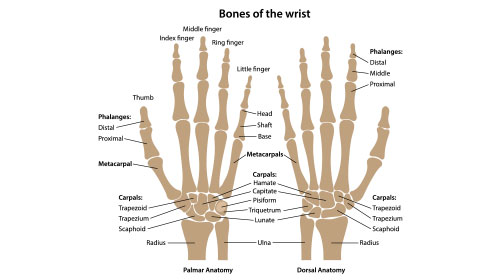
General Information
Bone is living tissue that requires a regular supply of blood for nourishment. If the blood supply to a bone stops, the bone can die, a condition known as osteonecrosis. That’s what happens in Kienböck’s disease, which affects the lunate, one of the small bones of the hand near the wrist.

Signs & Symptoms
The cause of Kienböck’s disease is unknown. Many people with Kienböck’s disease think they have a sprained wrist at first. They may have experienced some form of trauma to the wrist, such as a fall. This type of trauma can disrupt the blood flow to the lunate. In most people, two vessels supply blood to the lunate, but in some people there is only one source. This puts them at greater risk for developing the disease. As the disease progresses, other signs and symptoms are noted, including:
- A painful and sometimes swollen wrist
- Limited range of motion in the affected wrist (stiffness)
- Decreased grip strength in the hand
- Tenderness directly over the bone (on the top of the hand at about the middle of the wrist)
- Pain or difficulty in turning the hand upward
Progression
Kienböck’s disease follows a specific progressive pattern through four stages.
Stage 1:
Symptoms are similar to those of a wrist sprain. X-rays may be normal or show a line indicating a possible fracture. Magnetic resonance imaging (MRI) may also be helpful in making the diagnosis in this early stage.
Stage 2:
The lunate bone begins to harden. On an X-ray, it may appear brighter or whiter than the surrounding bones. These changes indicate that the bone is dying. Either an MRI or a computed tomography (CT) scan may be used to assess the condition of the bone. Recurrent pain, swelling and wrist tenderness are common.
Stage 3:
The dead bone begins to collapse and break into pieces. The surrounding bones may begin to shift position. Patients experience increasing pain, weakness in gripping, and limited motion.
Stage 4:
The surfaces of adjoining bones are affected, resulting in arthritis of the wrist.
Diagnosis & Treatment
In its early stages, Kienböck’s disease may be difficult to diagnose because the symptoms are so similar to those of a sprained wrist. Even X-rays of the wrist may appear normal. At this point, the goal of treatment is to relieve the pressure on the lunate and help restore blood flow within the bone. Your physician may splint or cast your wrist for two to three weeks. Anti-inflammatory medications such as aspirin or ibuprofen will help relieve any pain and reduce swelling. If the pain continues, your physician may refer you to a hand surgeon for further evaluation.
Surgical Options
Although there is no cure, there are several surgical options for treating the more advanced stages of Kienböck’s disease. The right procedure for you will depend on several factors, including disease progression, your personal activity levels and goals and your surgeon’s experience with various procedures. Do not hesitate to discuss these options with your hand surgeon and to ask why he or she is recommending a particular procedure.
In some cases, returning the blood supply to the bone (revascularization) may be possible. This procedure uses a bone graft from the inner bone of the lower arm. It may be combined with an external fixator, a metal device that helps relieve pressure on the lunate and preserve the spacing between bones.
If the bones of the lower arm are uneven in length, a joint leveling procedure may be recommended. Bones can be made longer with bone grafts, or shortened by removing a section of the bone. This reduces the compressive forces on the lunate and seems to halt progression of the disease. If the lunate is severely collapsed or fragmented, it can be removed. The two bones on either side of it are also removed. This procedure is called a proximal row carpectomy and will relieve pain while maintaining partial wrist motion.
Another way to ease pressure on the bone is to fuse several of the small bones of the hand together. However, this will not improve range of motion. If the disease has progressed to severe arthritis of the wrist, fusing the bones will reduce pain and help maintain function, although motion is limited.
